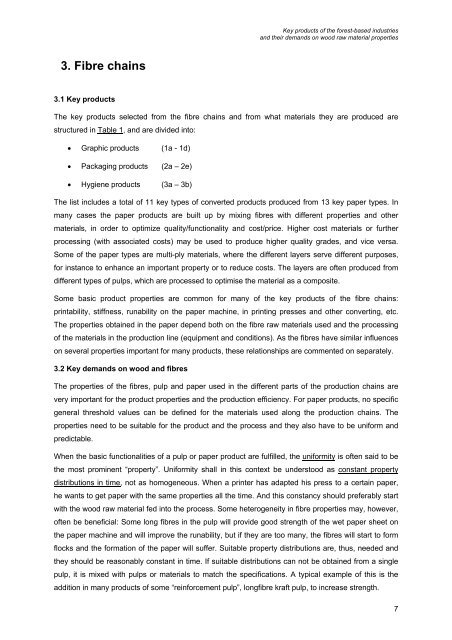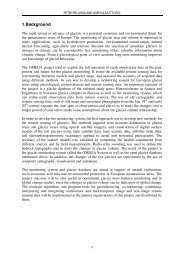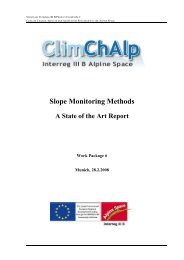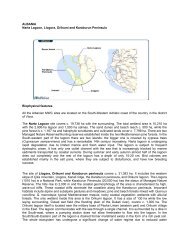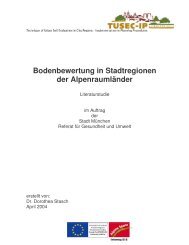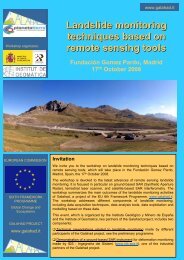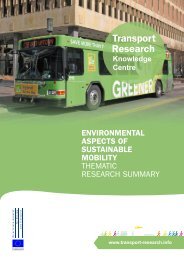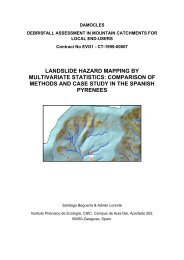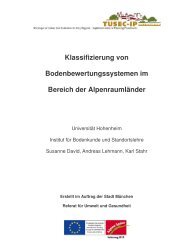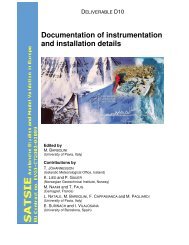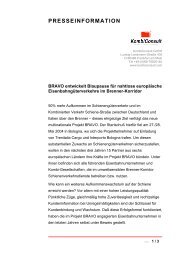Deliverable D3.1.2 Key products of the forest-based industries and ...
Deliverable D3.1.2 Key products of the forest-based industries and ...
Deliverable D3.1.2 Key products of the forest-based industries and ...
You also want an ePaper? Increase the reach of your titles
YUMPU automatically turns print PDFs into web optimized ePapers that Google loves.
<strong>Key</strong> <strong>products</strong> <strong>of</strong> <strong>the</strong> <strong>forest</strong>-<strong>based</strong> <strong>industries</strong><strong>and</strong> <strong>the</strong>ir dem<strong>and</strong>s on wood raw material properties3. Fibre chains3.1 <strong>Key</strong> <strong>products</strong>The key <strong>products</strong> selected from <strong>the</strong> fibre chains <strong>and</strong> from what materials <strong>the</strong>y are produced arestructured in Table 1, <strong>and</strong> are divided into:• Graphic <strong>products</strong> (1a - 1d)• Packaging <strong>products</strong> (2a – 2e)• Hygiene <strong>products</strong> (3a – 3b)The list includes a total <strong>of</strong> 11 key types <strong>of</strong> converted <strong>products</strong> produced from 13 key paper types. Inmany cases <strong>the</strong> paper <strong>products</strong> are built up by mixing fibres with different properties <strong>and</strong> o<strong>the</strong>rmaterials, in order to optimize quality/functionality <strong>and</strong> cost/price. Higher cost materials or fur<strong>the</strong>rprocessing (with associated costs) may be used to produce higher quality grades, <strong>and</strong> vice versa.Some <strong>of</strong> <strong>the</strong> paper types are multi-ply materials, where <strong>the</strong> different layers serve different purposes,for instance to enhance an important property or to reduce costs. The layers are <strong>of</strong>ten produced fromdifferent types <strong>of</strong> pulps, which are processed to optimise <strong>the</strong> material as a composite.Some basic product properties are common for many <strong>of</strong> <strong>the</strong> key <strong>products</strong> <strong>of</strong> <strong>the</strong> fibre chains:printability, stiffness, runability on <strong>the</strong> paper machine, in printing presses <strong>and</strong> o<strong>the</strong>r converting, etc.The properties obtained in <strong>the</strong> paper depend both on <strong>the</strong> fibre raw materials used <strong>and</strong> <strong>the</strong> processing<strong>of</strong> <strong>the</strong> materials in <strong>the</strong> production line (equipment <strong>and</strong> conditions). As <strong>the</strong> fibres have similar influenceson several properties important for many <strong>products</strong>, <strong>the</strong>se relationships are commented on separately.3.2 <strong>Key</strong> dem<strong>and</strong>s on wood <strong>and</strong> fibresThe properties <strong>of</strong> <strong>the</strong> fibres, pulp <strong>and</strong> paper used in <strong>the</strong> different parts <strong>of</strong> <strong>the</strong> production chains arevery important for <strong>the</strong> product properties <strong>and</strong> <strong>the</strong> production efficiency. For paper <strong>products</strong>, no specificgeneral threshold values can be defined for <strong>the</strong> materials used along <strong>the</strong> production chains. Theproperties need to be suitable for <strong>the</strong> product <strong>and</strong> <strong>the</strong> process <strong>and</strong> <strong>the</strong>y also have to be uniform <strong>and</strong>predictable.When <strong>the</strong> basic functionalities <strong>of</strong> a pulp or paper product are fulfilled, <strong>the</strong> uniformity is <strong>of</strong>ten said to be<strong>the</strong> most prominent “property”. Uniformity shall in this context be understood as constant propertydistributions in time, not as homogeneous. When a printer has adapted his press to a certain paper,he wants to get paper with <strong>the</strong> same properties all <strong>the</strong> time. And this constancy should preferably startwith <strong>the</strong> wood raw material fed into <strong>the</strong> process. Some heterogeneity in fibre properties may, however,<strong>of</strong>ten be beneficial: Some long fibres in <strong>the</strong> pulp will provide good strength <strong>of</strong> <strong>the</strong> wet paper sheet on<strong>the</strong> paper machine <strong>and</strong> will improve <strong>the</strong> runability, but if <strong>the</strong>y are too many, <strong>the</strong> fibres will start to formflocks <strong>and</strong> <strong>the</strong> formation <strong>of</strong> <strong>the</strong> paper will suffer. Suitable property distributions are, thus, needed <strong>and</strong><strong>the</strong>y should be reasonably constant in time. If suitable distributions can not be obtained from a singlepulp, it is mixed with pulps or materials to match <strong>the</strong> specifications. A typical example <strong>of</strong> this is <strong>the</strong>addition in many <strong>products</strong> <strong>of</strong> some “reinforcement pulp”, longfibre kraft pulp, to increase strength.7


